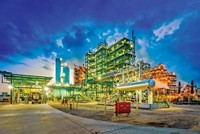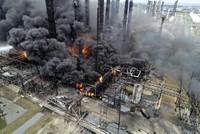Advertisement
Grab your lab coat. Let's get started
Welcome!
Welcome!
Create an account below to get 6 C&EN articles per month, receive newsletters and more - all free.
It seems this is your first time logging in online. Please enter the following information to continue.
As an ACS member you automatically get access to this site. All we need is few more details to create your reading experience.
Not you? Sign in with a different account.
Not you? Sign in with a different account.
ERROR 1
ERROR 1
ERROR 2
ERROR 2
ERROR 2
ERROR 2
ERROR 2
Password and Confirm password must match.
If you have an ACS member number, please enter it here so we can link this account to your membership. (optional)
ERROR 2
ACS values your privacy. By submitting your information, you are gaining access to C&EN and subscribing to our weekly newsletter. We use the information you provide to make your reading experience better, and we will never sell your data to third party members.
Environment
Vent and burn 'unnecessary' in East Palestine, safety board finds
Incomplete and misleading information provided by Norfolk Southern and its contractors led to the release and burning of vinyl chloride
by Priyanka Runwal
June 27, 2024
| A version of this story appeared in
Volume 102, Issue 20

Presenting the final results of its investigation into the Norfolk Southern train derailment in East Palestine, Ohio, the National Transportation Safety Board said the release and burning of vinyl chloride—a known carcinogen—from several tank cars was “unnecessary.”
Among the board’s other findings were that an overheated wheel bearing did indeed cause the crash and that a large fire at the site was started by highly flammable butyl acrylate that spilled from a punctured tank car.
In a hearing held on June 25, NTSB chair Jennifer Homendy accused Norfolk Southern of manufacturing evidence, delaying or failing to provide essential documents and data crucial to the investigation, and going so far as to threaten the board. She said the rail company’s abuse of its status as a party to the probe was “unprecedented” and “reprehensible.”
On Feb. 3, 2023, train 32N heading from Madison, Illinois, to Conway, Pennsylvania, derailed in East Palestine. Of the 38 cars that veered off the track, 11 carried highly flammable and hazardous industrial chemicals. These included vinyl chloride and butyl acrylate, an irritant to the nose, throat, and lungs when inhaled. Norfolk Southern and its contractors rejected alternatives and proposed vent and burn as the only viable option to remove vinyl chloride from five tank cars—a controversial choice that East Palestine’s fire chief, Keith Drabick, had 13 min to approve.
NTSB’s investigation suggests that the rail company provided incomplete and misleading information that resulted in green-lighting of the vent and burn. Norfolk Southern’s contractors were concerned that the stabilized vinyl chloride in one of the tank cars had started to polymerize, which could have caused the tank to explode and send toxic gas and shrapnel in all directions. The on-ground team had noted an increase in the previously stable temperature of the railcar’s shell, which led them to conclude that the exothermic reaction had commenced.
That is not plausible, according to William Carroll, an organic chemist who had testified as an independent expert during NTSB’s previous hearing, on June 22, 2023. He had worked at OxyChem—a manufacturer of vinyl chloride—for 37 years and is a former president of the American Chemical Society. ACS publishes C&EN but is not involved in editorial decisions.
Polymerization requires the use of initiator compounds to trigger the reaction, but none were present, Carroll tells C&EN. Also, the elevated temperature of 58.8 °C that the crew noted is “not enough temperature to do anything” to the vinyl chloride monomer, he says.
And the temperature of the railcar’s shell had started to decline before the decision to vent and burn was made. “If you actually had polymerization going on, the temperature would just continue to rise because there’s nothing to stop it,” Carroll says.
OxyVinyls, the OxyChem affiliate that manufactured the vinyl chloride on the Norfolk Southern train, also told the rail company that the probability of polymerization was low—a view that the rail company did not present to decision-makers. “Norfolk Southern and its contractors continued to assert the necessity of a vent and burn, even though available evidence should have led them to reevaluate their initial conclusion,” NTSB investigator Paul Stancil said at the final hearing.
In a June 25 statement, the rail company said that other options to safely remove vinyl chloride weren’t possible, because of the damage sustained by the derailed cars and dangerous on-site conditions. It also argued that the malfunctioning of the tanks’ pressure-relief devices could have prompted a catastrophic explosion, necessitating the controlled removal of vinyl chloride.
In its recommendations to the Federal Railroad Administration, the NTSB team has suggested clearer guidance on when to opt for the vent-and-burn option. It also made several other recommendations, including accelerated phase-out of DOT-111 tank cars for carrying flammable liquids such as the car that carried butyl acrylate. Because of their design, DOT-111s are particularly susceptible to breaching damage.
“The events that eventually led to the vent and burn could’ve been avoided had there been no DOT-111 tank cars carrying combustible and flammable liquids on this train,” Stancil said.
Meanwhile, many East Palestine residents whose lives have been upended by the train derailment are hoping for accountability. A pending class-action lawsuit in which Norfolk Southern would pay $600 million to compensate individuals and businesses affected by the derailment doesn’t cut it, says community member Zsuzsa Gyenes. “We need to go back to the drawing board and rewrite the terms so that they’re fair and reasonable,” she says.





Join the conversation
Contact the reporter
Submit a Letter to the Editor for publication
Engage with us on Twitter